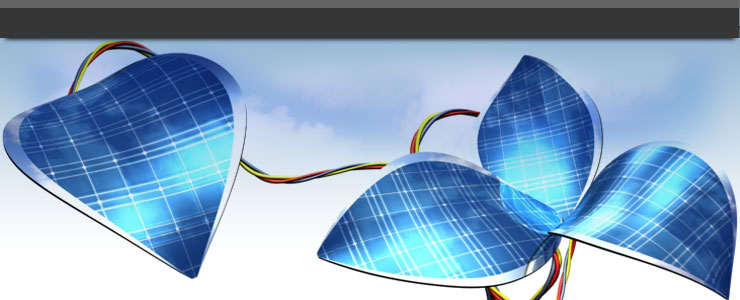Привіт Гість ( Вхід | Реєстрація )
| Rilian |
 Apr 19 2010, 23:58 Apr 19 2010, 23:58
Пост
#1
|
 interstellar           Група: Team member Повідомлень: 17 163 З нами з: 22-February 06 З: Торонто Користувач №: 184 Стать: НеСкажу Free-DC_CPID Парк машин: ноут и кусок сервера |
 Проект "The Clean Energy project - phase 2" Проект запущен 28 Июня 2010 ----------------------------------------------------------------------------------------------------------
Как присоединиться читайте в главном топике World Community Grid  ---------------------------------------------------------------------------------------------------------- Дата основания команды - 28.02.2005 Капитан - rilian ---------------------------------------------------------------------------------------------------------- О проекте: Ненасытный энергетический аппетит Люди живут на Земле уже несколько миллионов лет. Общества и культуры рождаются и умирают, а наше потребление энергии все время растет. За 2 прошлых века потребление энергии невероятно увеличилось, а за последние 10 лет стало просто неконтроллируемым. Большую часть добычи энергии взяла на себя нефтяная отрасль - подход, который наносит громадный вред нашей планете. У нас есть два выхода, уменьшить потребление энергии, или найти ее более подходящие источники. Собираем солнечный урожай Существует много видов возобновляемой энергии, и солнечная - самая многообещающая. В связи с изобилием солнечного света на всем земном шаре, солнечная энергия будет ключевой компонентой в энергетической стратегии будущего. Органические солнечные ячейки Есть несколько подходов к переработке солнечной энергии в электрическую, и каждый подход имеет свои преимущества и недостатки. Обычные кремниевые ячейки очень эффективны, но дорого стоят. Плюч, они не гибкие в плане мест, куда их можно установить. С другой стороны, органические фотоэлектрики (пластиковые солнечные ячейки) сравнительно дешевы, и могут использоваться в большем кол-ве областей. Но, они пока что малоэффективны, для массового использования. Представляем: Проект Чистая Энергия, вторая фаза Группа интузиастов-исследователей из Гарвардского Университета использовала World Community Grid для создания новых высокопроизводительных органических фотоэлектриков. Первая фаза их работы завершена, и запуск второй фазы назначен на конец Июня 2010. Клиенты для windows и mac выпущены 8 ноября 2010 года. Crunch on! С помощью World Community Grid смогут смоделировать миллионы молекул, чтобы найти лучшие кандидаты для создания солнечных ячеек будущего. Эти ученые прокладывают путь в решения в области энергетики будущего. Отпразднуйте 40-ю годовщину Дня Земли, пожертвуя ваши неиспользованные процессорные ресурсы и помогите движению за возобновляемую энергию! Ссылки по теме:Как происходят рассчеты: программа подбирает структуру поглощающей поверхности и подвергает ее воздействию освещения. Поверхность выделяет электроэнергию и нагревается. Программа измеряет эти параметры со временем Как выглядит графический клиент: CODE [img]http://i40.tinypic.com/1rd7cy.jpg[/img] График работы проекта  Це повідомлення відредагував Rilian: Nov 15 2010, 01:27 |
  |
Відповідей
| Rilian |
 Jul 8 2013, 12:04 Jul 8 2013, 12:04
Пост
#2
|
 interstellar           Група: Team member Повідомлень: 17 163 З нами з: 22-February 06 З: Торонто Користувач №: 184 Стать: НеСкажу Free-DC_CPID Парк машин: ноут и кусок сервера |
Harvard publishes World Community Grid data, rating millions of compounds for use in solar cells
Ученые из гарварда публикуют в открытый доступ информацию о 2.3 миллиона различных органических соединений в рамках работы над солнечными панелями. Кому надо - качайте и изучайте  The Clean Energy Project research team at Harvard University, led by Professor Alбn Aspuru-Guzik In a IBM press release today, Harvard researchers launched a free database (www.molecularspace.org) that catalogues 2.3 million organic, carbon-based compounds with potential for use in solar cells. As part of The Clean Energy Project, the electronic properties of these compounds have been analyzed to determine which ones may be viable candidates for converting sunlight to electricity. Scientists around the world can now use Harvard's database to continue investigating the most promising candidates. It can be used to help advance the development of efficient, inexpensive organic semiconductors, and ultimately, electricity-generating devices such as solar cells. For the past three years, volunteer contributors to the World Community Grid initiative have been donating the computing time needed to run these simulations and predict which molecules have the most promising electronic properties. The project has already screened 2.3 million compounds and identified approximately 1,000 that might lead to organic solar cells with 11% efficiency in converting sunlight into electrical energy, and another 35,000 that may achieve 10% efficiency - double the efficiency of most current organic solar cells in production. These efficiency values correspond to the current record holders, but most production cells only convert 4% to 5% of sunlight into electricity. Silicon-based photovoltaic materials provide about 15% efficiency but generally require a much more expensive production process. Organic solar cells offer more possibilities than those made with traditional materials like silicon. For example, carbon-based materials can be as cheaply manufactured on a massive scale with the same technology that currently produces photographic films - making them useful to remote and impoverished populations. Versions of organic solar cells could be coated, painted, or sprayed on roofs, windows and walls, and can be thin and light enough to be applied to portable devices.  The news was welcomed by the White House Office of Science and Technology Policy, which has previously featured the Clean Energy Project in its Materials Genome Initiative (MGI). Thousands of volunteers all over the world continue to provide the computing power to run further simulations for this project, so it’s only fair that the results are published in the public domain. These computations would have taken a single computer over 17,000 years to complete, but they were calculated in only three years thanks to World Community Grid volunteers. The research project is ongoing, and new compounds will be added to the database as they are analyzed. This is just one more example of how World Community Grid volunteers are supporting research that can make the world a better place. For more information, read the full press release here: http://ibm.co/15dnrp0. Also, Professor Alбn Aspuru-Guzik from Harvard University discusses this milestone in this blog post: http://ibm.co/12OKyKG -------------------- |
Повідомлення у даній Темі
 Rilian Clean Energy Project - Phase 2 Apr 19 2010, 23:58
Rilian Clean Energy Project - Phase 2 Apr 19 2010, 23:58
 kornq Ура! Буду его считать по любому. :bq: Apr 20 2010, 14:22
kornq Ура! Буду его считать по любому. :bq: Apr 20 2010, 14:22
 Arbalet Отаке, значит у меня так и останется только серебр... Apr 20 2010, 22:20
Arbalet Отаке, значит у меня так и останется только серебр... Apr 20 2010, 22:20
 Rilian После долгих бета-тестирований, [b]выпущен клиент ... Jun 28 2010, 21:08
Rilian После долгих бета-тестирований, [b]выпущен клиент ... Jun 28 2010, 21:08
 Rilian Dear World Community Grid users:
Welcome to the s... Jun 28 2010, 21:22
Rilian Dear World Community Grid users:
Welcome to the s... Jun 28 2010, 21:22
 Arbalet В системных требованиях к компу значатся - 1 гиг о... Jun 28 2010, 21:38
Arbalet В системных требованиях к компу значатся - 1 гиг о... Jun 28 2010, 21:38
 Sirchyk Linux є. проте коли його ставив виділив замало міс... Jun 29 2010, 20:21
Sirchyk Linux є. проте коли його ставив виділив замало міс... Jun 29 2010, 20:21
 KING100N Попробую сегодня в виртуалке запустить. Еще, обрат... Jun 29 2010, 21:47
KING100N Попробую сегодня в виртуалке запустить. Еще, обрат... Jun 29 2010, 21:47
 Rilian KING100N, убунту попробуй :)
софт писали изначаль... Jun 29 2010, 22:16
Rilian KING100N, убунту попробуй :)
софт писали изначаль... Jun 29 2010, 22:16
 ReMMeR KING100N, Бери Линукс Минт. Это убунта, но допилен... Jun 29 2010, 23:42
ReMMeR KING100N, Бери Линукс Минт. Это убунта, но допилен... Jun 29 2010, 23:42
 Rilian Наверное аплоад большой потому что им надо не коне... Jun 30 2010, 01:56
Rilian Наверное аплоад большой потому что им надо не коне... Jun 30 2010, 01:56
 Rilian Dear World Community Grid member,
Thank you for y... Jul 1 2010, 23:40
Rilian Dear World Community Grid member,
Thank you for y... Jul 1 2010, 23:40
 Brodyaga Онако, у них и запросы... Будем пробовать, когда в... Jul 2 2010, 09:52
Brodyaga Онако, у них и запросы... Будем пробовать, когда в... Jul 2 2010, 09:52
 KING100N видимо мне и попалось задание на 12 часов в линукс... Jul 2 2010, 11:34
KING100N видимо мне и попалось задание на 12 часов в линукс... Jul 2 2010, 11:34
 Rilian Кто-то уже смог посчитать хоть одну ВЮ? Выложите с... Jul 3 2010, 16:33
Rilian Кто-то уже смог посчитать хоть одну ВЮ? Выложите с... Jul 3 2010, 16:33
 Rilian пока что запуск виндовых клиентов CEP2 отложен, пр... Jul 28 2010, 01:36
Rilian пока что запуск виндовых клиентов CEP2 отложен, пр... Jul 28 2010, 01:36
 nikelong Еще какая то инфа по проекту на русском. Я не вчит... Aug 26 2010, 19:43
nikelong Еще какая то инфа по проекту на русском. Я не вчит... Aug 26 2010, 19:43
 Rilian О, кранчеры боинк-ру перевели FAQ. Надо оформить ш... Aug 29 2010, 09:07
Rilian О, кранчеры боинк-ру перевели FAQ. Надо оформить ш... Aug 29 2010, 09:07
 Rilian The Windows version is currently running in our in... Sep 2 2010, 23:01
Rilian The Windows version is currently running in our in... Sep 2 2010, 23:01
 Rilian Сегодня началось бета-тестирование под Windows
Пе... Sep 15 2010, 14:50
Rilian Сегодня началось бета-тестирование под Windows
Пе... Sep 15 2010, 14:50  |
1 Користувачів переглядають дану тему (1 Гостей і 0 Прихованих Користувачів)
0 Користувачів:

|
Lo-Fi Версія | Поточний час: 14th December 2025 - 06:19 |

















